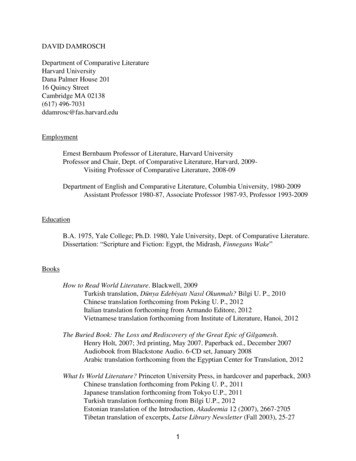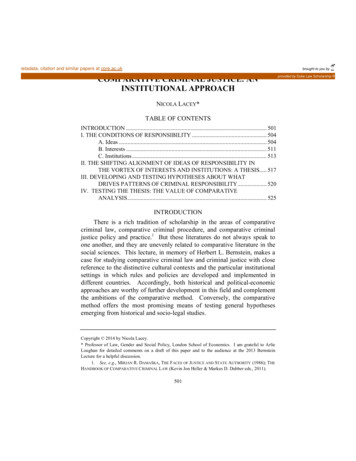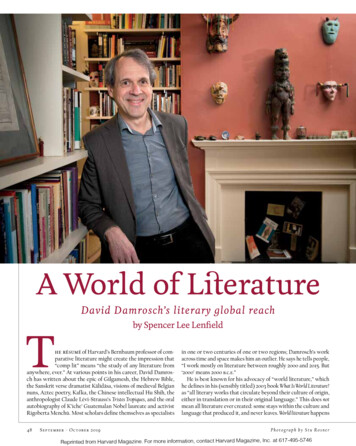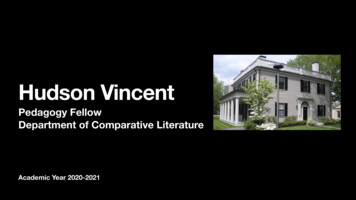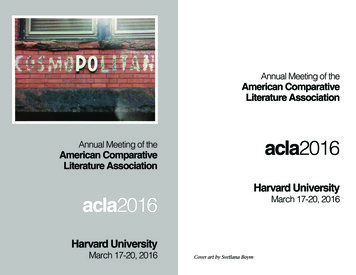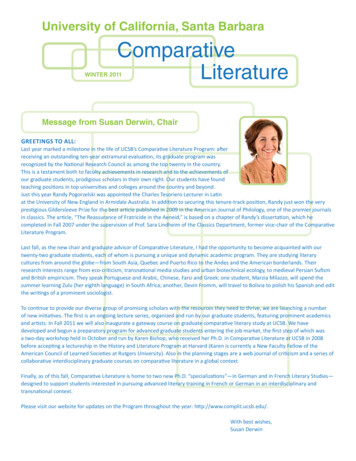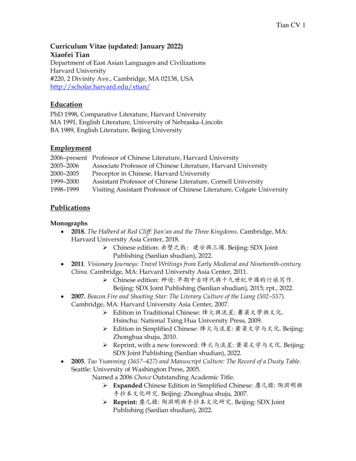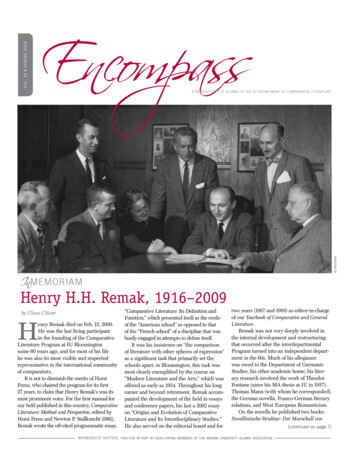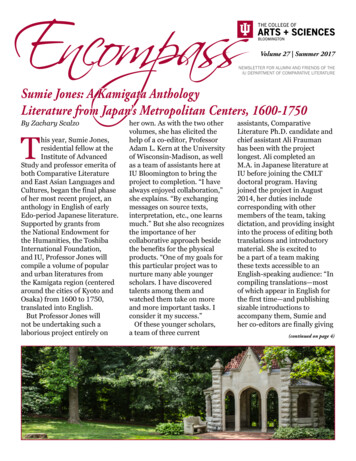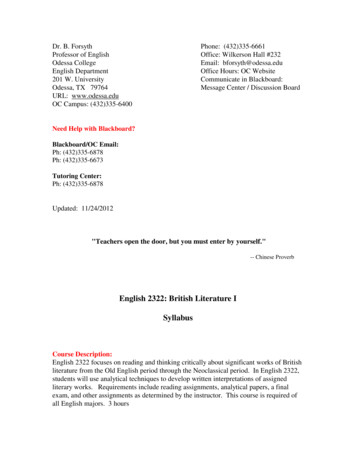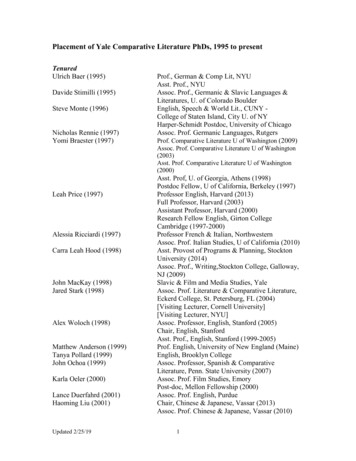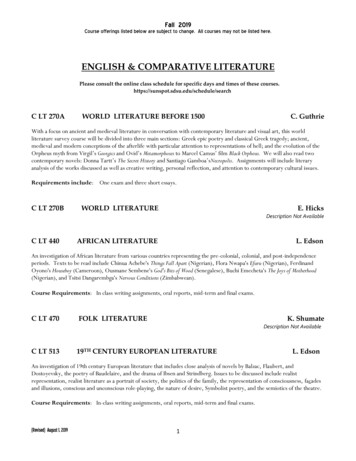
Transcription
Fall 2019Course offerings listed below are subject to change. All courses may not be listed here.ENGLISH & COMPARATIVE LITERATUREPlease consult the online class schedule for specific days and times of these courses.https://sunspot.sdsu.edu/schedule/searchC LT 270AWORLD LITERATURE BEFORE 1500C. GuthrieWith a focus on ancient and medieval literature in conversation with contemporary literature and visual art, this worldliterature survey course will be divided into three main sections: Greek epic poetry and classical Greek tragedy; ancient,medieval and modern conceptions of the afterlife with particular attention to representations of hell; and the evolution of theOrpheus myth from Virgil’s Georgics and Ovid’s Metamorphoses to Marcel Camus’ film Black Orpheus. We will also read twocontemporary novels: Donna Tartt’s The Secret History and Santiago Gamboa’sNecropolis. Assignments will include literaryanalysis of the works discussed as well as creative writing, personal reflection, and attention to contemporary cultural issues.Requirements include: One exam and three short essays.C LT 270BC LT 440WORLD LITERATUREE. HicksDescription Not AvailableAFRICAN LITERATUREL. EdsonAn investigation of African literature from various countries representing the pre-colonial, colonial, and post-independenceperiods. Texts to be read include Chinua Achebe's Things Fall Apart (Nigerian), Flora Nwapa's Efuru (Nigerian), FerdinandOyono's Houseboy (Cameroon), Ousmane Sembene's God's Bits of Wood (Senegalese), Buchi Emecheta's The Joys of Motherhood(Nigerian), and Tsitsi Dangarembga's Nervous Conditions (Zimbabwean).Course Requirements: In class writing assignments, oral reports, mid-term and final exams.C LT 470FOLK LITERATUREK. ShumateC LT 51319TH CENTURY EUROPEAN LITERATUREDescription Not AvailableL. EdsonAn investigation of 19th century European literature that includes close analysis of novels by Balzac, Flaubert, andDostoyevsky, the poetry of Baudelaire, and the drama of Ibsen and Strindberg. Issues to be discussed include realistrepresentation, realist literature as a portrait of society, the politics of the family, the representation of consciousness, facadesand illusions, conscious and unconscious role-playing, the nature of desire, Symbolist poetry, and the semiotics of the theatre.Course Requirements: In-class writing assignments, oral reports, mid-term and final exams.(Revised) August 1, 20191
Fall 2019Course offerings listed below are subject to change. All courses may not be listed here.C LT 580COMBAT JOURNALISM: WITNESS & TESTIMONYT. CummingsWhen she described her war correspondence, Martha Gellhorn wrote, "I wrote very fast, as I had to; and I was always afraidthat I would forget the exact sound, smell, words, gestures which were special to this moment and this place. I hope I learnedto write a bit better as the years passed. The point of these articles is that they are true; they tell what I saw. Perhaps they willremind others, as they remind me, of the face of war."In this comparative literature course, we will read some of the writings by first-hand witnesses to war, whether they saw anancient battle in another land or happened to be caught in a battle near-by. Although our work will focus on some of the mostfamous US war correspondents, we will also view films detailing the work of war correspondents and read writings by authorsfrom around the globe.Requirements: Participation, in-class discussion, two essays, possibility of non-fiction creative writing assignments as well.C LT 594BODIES & EXPERIMENTSY. HowardThis is a comparative cultural studies course that will investigate the varying degrees of cross-pollination between bodilyexperiences and experimental practices. We will read, watch, and listen to a selection of written, visual, and auditoryexamples that focus on corporeal topographies and radical textual qualities. Responding to and reflecting contemporarypolitics of the body, the experiments under consideration will include (but are not limited to) William Burroughs’s The SoftMachine, Catherine Lord’s The Summer of Her Baldness, and David Lynch’s Mulholland Drive. While we will approach these textsin loose chronological order, they should be thought about in terms of their affinities, conflicts, and contradictions in shapingand being shaped by contemporary gendered, racial, and sexual subjectivities.C LT 595SOUND VISIONY. HowardThis course borrows its name from David Bowie’s song of the same name and will operate in the spirit of thinking aboutsound’s and music’s relationship with moving image culture. We will explore the role of the concert/performance scene incult and underground film such as Uli Edel’s Christiane F and Tony Scott’s The Hunger (both of which include Bowie);punk/postpunk cinema such as Penelope Spheeris’s The Decline of Western Civilization; the role of the soundtrack and score inhorror and drug cinema; as well as a range of experimental and queer approaches to cinematic practice by Barbara Hammer,Kenneth Anger, and others that centralize the role of sound.C LT 595AFROFUTURISMD. LeongWhat do the films of Ryan Coogler (i.e., Black Panther) and Boots Riley (i.e., Sorry to Bother You), the novels of Octavia Butler,the albums of Janelle Monae, and the art of Wangechi Mutu have in common? Like other examples of Afrofuturism, thesecreative works approach issues of science, technology, and the future through the lens of the African Diaspora, asking: How dothe histories of slavery, colonialism, and civil rights offer us new ways of understanding science and technology? What can thefigures of the “alien” and “robot” teach us about what it means to be human? And what are the connections between blackness,freedom, space, and time? By exploring the vibrant intersections between speculative fiction, contemporary technoculture,and race as they emerge in Black literature, art, and music, this course will examine how Afrofuturism might offer usalternative visions of the future.(Revised) August 1, 20192
Fall 2019Course offerings listed below are subject to change. All courses may not be listed here.ENGL 220INTRODUCTION TO LITERATUREENGL 220INTRODUCTION TO LITERATURET. AsimDescription Not AvailableM. MarshallOthers and OutsidersFor centuries, literature, music, and film have served as gathering places for Others and Outsiders: those who are perceived asbeing different in some fundamental way, deemed inferior, and judged accordingly—as Claudia Rankine asserts, those who areboth “invisible and hyper-visible.” In this course we will examine and celebrate various forms of Otherness and how theseforms are portrayed in novels, short stories, poetry, performance art, and music. Through deep reading, spirited discussion,and thoughtful inquiry, we will hone our critical thinking, reading, and negotiating skills.ENGL 220INTRODUCTION TO LITERATUREENGL 220INTRODUCTION TO LITERATUREENGL 220INTRODUCTION TO LITERATUREENGL 220INTRODUCTION TO LITERATUREENGL 220INTRODUCTION TO LITERATURES. Aslagson-SaharDescription Not AvailableR. CrossDescription Not AvailableC. GutherieDescription Not AvailableJ. MaguireDescription Not AvailableW. NericcioNaked Sexy Beasts! An Introduction to the Study of Literature,Film, Comics, Photography, and Streaming MediaThe title, of course, is a tease—an excuse for you to take a General Education class in Literature and Film Studies, as opposed to, say, anonline class on tetherball, or god knows whatever else is passing for a GE @ SDSU these days. In our English 220: Introduction toLiterature class we will read books, and write about them. Our focus is all things naked, sexy, and bestial!But that does not mean we will be pornographic (no groaning!). Instead, we will focus on stories that are written (novels), screened(television and film), drawn (graphic narrative/comics), and shot (photography) that reveal humanity at its most beastly, most naked, mostsexy.Take the word “naked,” for instance. Of course it means to be without clothes, a state we associate with the “sexual,” but “naked” alsomeans “[h]aving no defence or protection; open or exposed to assault or injury; vulnerable” and, as well, “[d]estitute of means; withoutresources” (thanks Oxford English Dictionary).(Revised) August 1, 20193
Fall 2019Course offerings listed below are subject to change. All courses may not be listed here.The same goes for the term “Beast”: the word might, at first glance, conjure images of vampires and werewolves—of all kinds of humanand inhuman monsters, but beastly men and women are everywhere (and not just in Washington D. C.). And they make up a huge part ofwhat comes to be known as literature! Can you say Frankenstein!? I knew you could.So our mad dash through 16 weeks of beastly, sexy, naked humans will be an adventure—the lineup of movies and books and comics is stillin flux but for sure we will be reading The Island of Doctor Moreau by H.G. Wells (Broadview Press); The Strange Case of Dr. Jekyll and Mr.Hyde by Robert Louis Stevenson; and “The Rat Man Case History” by Sigmund Freud. Movie screenings will include Fur: An ImaginaryPortrait of Diane Arbus by Steven Shainberg; Frances Ha by Greta Gerwig and Noah Baumbach; and Jonathan Glazer’s Sexy Beast (of course, asthe class is built around this outstanding piece of cinema).Other likely figures on the syllabus are Diane Arbus, Myriam Gurba, Remedios Varo, and more. The class is open to all majors; graduatestudents and advanced undergraduates who want to take the class for upper-division or graduate credit should come see me after the firstclass.ENGL 220INTRODUCTION TO LITERATUREENGL 220INTRODUCTION TO LITERATUREENGL 250ALITERATURE OF THE U.S.ENGL 250BLITERATURE OF THE U.S.ENGL 260AENGLISH LITERATURE TO 1800B. WarnkeDescription Not AvailableJ. ZeidersDescription Not AvailableC. ColquittDescription Not AvailableJ. ThomasDescription Not AvailableQ. BaileyThis course hopes to introduce you to some of the best British literature from its beginning until about the time of theAmerican Revolution. That is quite a long time—about a millennium—so we won’t be looking to cover everything (or evenmost things). Instead, we’ll look at some of the more interesting and long-lasting works and characters from those years Beowulf, King Arthur, Queen Guinevere, and the knights of the Round Table, Robin Hood & Maid Marion. We’ll likely meetcharacters like Chaucer’s Miller and Pardoner, Shakespeare’s Othello and Macbeth, Milton’s Satan, and Dryden’s Absalomand Achitophel; we’ll trace the development of the sonnet form from its introduction into English; and we’ll think about whyparticular works stick with us and why others are assigned to the scrapheap of literary history.(Revised) August 1, 20194
Fall 2019Course offerings listed below are subject to change. All courses may not be listed here.ENGL 260BENGLISH LITERATURET. CummingsThe Romantics to the PresentHow did we get here!?Whether it’s “The Crown” or the latest James Bond flick, 2814’s dreamy sounds or Hockney’s dizzying “Road to Yorkthrough Sledmere,” British art and culture play a major role on the world stage. They long have.The impact of British literature may be immeasurable, but the impact and the works bear scrutiny. In this survey ofBritish literature from the Romantic era to the present, we will explore British cultural phenomena by reading threehistorical novels and extensively exploring three eras of poetry. While we will certainly read these works for the pleasure theybring, we will also ask how these texts helped shape British literature and England as a nation. In short, our running questionwill be: How did we get here?.Or to be more precise, How did they get there?! In thinking through these questions, we willfind that while all the authors we read were intent on exploring their own histories, they did so with the intention ofcreating a new world.Requirements: Read all required texts, participate daily by bringing in your written comments on texts toshare in small and large.ENGL 280INTRODUCTION TO CREATIVE WRITINGK. KroeberDescription Not AvailableIn this course we will cover a multitude of various forms that creative writing can take. There is no one-size-fits-all approachto creativity and we will utilize this course to challenge any preconceived notions of that. We will read and analyze one novel(or two novellas), numerous flash fiction pieces, poems, and hybrid-texts, as well as some pieces of visual medium and variousexperimental forms. By the end of the semester students will be able to effectively examine the techniques utilized by anumber of contemporary authors in order to aid in the development of their own writing.Through textual analysis and workshop discussion, we will engage thoroughly in the process of writing—that of yourself, yourpeers, and those who came before you.ENGL 280ENGL 301INTRODUCTION TO CREATIVE WRITINGPSYCHOLOGICAL NOVELB. LittrellDescription Not AvailableT. CummingsWhen people ask what a psychological novel is, it seems appropriate to respond by asking whether all novels are psychological.A novel is in part the exploration of the ways characters respond to the world, and that response is largely interior.While not all writing endeavors probe or depict the workings of the inner life, we will test the boundaries of this genre byreading a work of historical fiction, a trial novel, and a contemporary mystery alongside a romance-fable-political manifesto.We'll frame our readings by spending the first three weeks studying Western psychology and sections of the Abhidhamma.Requirements: Two short papers, in-class discussion, participation.(Revised) August 1, 20195
Fall 2019Course offerings listed below are subject to change. All courses may not be listed here.ENGL 306AENGL 306WCHILDREN'S LITERATUREADVANCED COMPOSITIONT. Asim(ENGL 306A & W are taken concurrently)Monsters under the bed? Trolls under the bridge? A nameless menace that lurks under the stairs? The theme of fear inchildren’s literature seems as prevalent as lessons about colors, shapes, and letters, which indicates that fear is yet another partof life that young minds must learn to accept, accommodate, and explore as just another building block of social identity. Thissemester, we will focus on those monstrous characters—witches, (were)wolves, clowns, and ghosts—that haunt the pagesand the psyches of children (and the adults they become) through the genres of fantasy and horror. In this way, we willchallenge and disrupt the standard notions of fantasy, horror, fear, and the delicious pleasure (or trauma) that comes withconfronting that which frightens us.ENGL 306AENGL 306WCHILDREN'S LITERATURE (and)ADVANCED COMPOSITIONM. GalbraithChildren’s Literature for Liberal Studies Majors(ENGL 306A & W are taken concurrently)English 306A and 306W are linked courses. English 306A asks you to read fairy tales, family novels, picture books, chapterbooks, and to view related forms of narrative for children such as cartoons, comics, and movies. English 306W asks you towrite compositions about the literature you read for 306A.Theme for the fall semester: Dreamscapes in different media. Sample readings and films:Andersen’s Fairy Tales (book)Where the Wild Things Are, Tar Beach, The Polar Express (picture books)The Arrival (graphic novel)Holes (book and movie)My Neighbor Totoro (movie)ENGL 308WLITERARY STUDYE. FramptonThis class will answer many of your questions and address many of your concerns. Who is Terry Eagleton anyway? What is theM.L.A.? When do you need an apostrophe? Where can I find a “peer-reviewed” essay? Why do some essays earn high gradeswhile others don’t? How can I take a stand in life, even when writing about literature? In short, there are no dumb questions inthis class. In order to answer as many of these questions as possible and have fun at the same time, we’ll read some excellentliterary work, considering how different literary theories can provide useful tools for our own analysis of such work. We’llalso review the nuts and bolts of academic writing, from grammar and punctuation to research and citation.By the end of the semester, you’ll be empowered with a clearer understanding of methods of literary analysis, concepts andterminology of literary study, research techniques, and the value of your voice.Requirements: There will be brief written assignments, a final research essay, a midterm, and a final exam. Activeparticipation in class discussions, debates, and exercises is a key component of the course, helping tofurther develop your interpersonal and public speaking skills.(Revised) August 1, 20196
Fall 2019Course offerings listed below are subject to change. All courses may not be listed here.ENGL 308WLITERARY STUDYC. GuthrieThe aim of this course is to teach you how to write about literature. You will learn how to close-read texts, how to mastertechniques of literary-critical research, and how to identify different literary critical approaches, some of which you will applyto the primary texts chosen for the course. We will also cover the more basic elements of writing: grammar, mechanics, andcitation. Requirements will include active class participation, short written assignments that you will be expected to revise inresponse to instructor and peer critiques, and a final research paper.ENGL 308WENGL 401LITERARY STUDYK. ShumateDescription Not AvailableCHILDHOOD'S LITERATUREA. MatosIdeologies of Childhood, Adolescence, and Adulthood in Youth LiteratureWhy are the divisions between developmental stages such as childhood, adolescence, and adulthood so difficult to sustain?Why are an increasing number of adults reading texts that are crafted with a younger audience in mind? How can youthliterature push older readers to acknowledge the value of keeping your “inner-child” intact, and what do we even mean whenreferring to our “inner-child”? This course is a broad introduction to the overarching issues and ideological concerns that arisein the study of children’s and young adult literature. We will develop answers to the questions above by examining a series of“classic,” popular, and award-winning youth texts that interrogate, challenge, and/or subvert the dichotomy betweenchildhood and adulthood. Furthermore, we will challenge the impulse to approach youth literature as “simple,”“unsophisticated,” and “didactic” by examining the literary and cultural merits of these texts. By the time the course is over,you will develop a sophisticated understanding of how complex, deep, and meaningful children’s and young adult literaturecan be.Potential texts that will be discussed include:A.A. Milne’s The Complete Tales of Winnie-The-PoohAntoine de Saint-Exupéry’s The Little PrinceBenjamin Alire Sáenz’s Aristotle and Dante Discover the Secrets of the UniverseGene Luen Yang’s American Born ChineseJ.K. Rowling’s Harry Potter and the Sorcerer’s StoneLois Lowry’s The GiverMargarita Engle’s Enchanted Air: Two Cultures, Two WingsPeter Brown’s The Wild RobotENGL 401CHILDHOOD'S LITERATUREENGL 495FICTION INTERNATIONAL INTERNSHIP(CR/NC Course)(Revised) August 1, 20197K. ShumateDescription Not AvailableS-P Martin
Fall 2019Course offerings listed below are subject to change. All courses may not be listed here.ENGL 495POETRY INTERNATIONAL INTERNSHIPS. Alcosser(CR/NC Course)Poetry International welcomes MFA, MA and undergraduate students to serve as interns. Interns may work offline or online,compiling our archival project, which includes the works of authors such as Nobel Prize, Pulitzer Prize, National Book Award,as well as many new and innovative poets. For MFA students, the internship can count as a literature course requirement andcan be repeated at least one time during your program of study.ENGL 501LITERATURE FOR CHILDRENM. GalbraithSemester theme: WaterThis semester we will immerse ourselves in watery worlds. Selected readings: "The Little Mermaid," The Water Babies,Huckleberry Finn, Pinocchio, Tuck Everlasting, Spirited Away.Requirements: Weekly writing assignments; three graded papers.ENGL 501LITERATURE FOR CHILDRENENGL 502ADOLESCENCE IN LITERATUREJ. ThomasDescription Not AvailableA. MatosFantastic Teens and Where to Find ThemThis course is a rigorous examination of contemporary young adult literature and media with speculative themes. It will focuson fantasy, dystopian, and science fiction texts, and as a collective, we will determine the capacity that these genres possess toshed light on precarious issues such as sexism, homophobia, transphobia, racism, and poverty. Wherein lies the literary,political, and cultural importance of these young adult genres? To what extent can these novels push readers to think criticallyabout themselves, their perspectives, their values, and their place in society? How and why do these genres reflect issues andconcerns present in contemporary society? We will address these questions by interrogating texts that are focalized through anadolescent’s consciousness, and in turn, we will debate the viability of approaching both real and fictional worlds through theeyes of teenagers from different walks of life. Please note that this course will focus heavily on matters of gender, sexuality,and queerness.Potential texts that will be discussed include:Adam Silvera’s They Both Die at the EndTomi Adeyemi’s Children of Blood and BoneJen Wang’s The Prince and the DressmakerLaura Ruby’s Bone GapPatrick Ness’ The Rest of Us Just Live HereTillie Walden’s On a Sunbeam(Revised) August 1, 20198
Fall 2019Course offerings listed below are subject to change. All courses may not be listed here.ENGL 503THE CHANGING LANDSCAPE OF CONTEMPORARYCHILDREN’S LITERATUREM. de la PenaOver the past fifteen years, children’s literature has exploded commercially. In this course we will explore the tremendousrange of works that currently fall into the category of children’s literature. We’ll examine contemporary picture books,chapter books, middle grade novels, young adult novels and new adult. In some cases, we will meet the author (either inperson or via Skype) after reading and discussing his or her work. We will pay special attention to recent shifts in the field,such as the call for more diverse representation and the fact that adults now make up the majority of the YA readership.ENGL 508WWRITING OF CRITICISME. FramptonSpeaking Your TruthAcademic writing can be a struggle; it can also be empowering. This class will provide you with tools and strategies that willhelp you to find your voice in the process of writing about literature and, as a result, to be more successful with it. Sinceliterary scholars today must have an understanding of what’s called “theory,” we’ll take a tour through aspects of thischallenging field via British critic Terry Eagleton. Experience with techniques of research and citation is equally important tocritics, and so we’ll cover that too. Also essential is a thorough command of standards of English grammar, and we’ll thereforereview a few basics that often get neglected. As a part of the process, we’ll read some wonderful poems, essays, and the novelsGreat Expectations (1861) and White Teeth (2000), applying our studies to the analysis of these. There will be brief writtenassignments, a final research essay, a midterm, and a final exam. Generous and tolerant participation in discussions, debates,and presentations is an essential component of the course, helping to develop your interpersonal and public speaking skills.ENGL 510BMODERNISMJ. PressmanModernism was a phenomenon of creative activity and formal experimentation that crossed oceans, art forms, and disciplinesin the early decades of the twentieth century. We are still reckoning its influence: postmodernism, digital modernism, andbeyond. This course explores a constellation of texts that challenge categories of genre and nationality to collectively representAnglo (British and American) Modernism. We read texts by such authors as T.S. Eliot, Ernest Hemingway, Gertrude Stein,Jean Toomer, and Virginia Woolf; we consider the impact of media, technology, and speed on the art of the period; weexplore the complex interstices of race, gender, and class in emergent concepts of subject and self. We dive into Modernismand grapple with Ezra Pound’s poignant but contradictory dictum from it: “make it new.”ENGL 523(Revised) August 1, 2019LITERATURE OF THE U.S. 1860 - 19209C. ColquittDescription Not Available
Fall 2019Course offerings listed below are subject to change. All courses may not be listed here.ENGL 525LITERATURE OF ENVIRONMENTAL JUSTICED. LeongThis course examines the literary, cultural, and political impact of the environmental justice movement, paying particularattention to how the dynamics of race, class, gender, and indigeneity affect our relationships to the environment. As a postcivil rights formation, the environmental justice movement seeks to address the uneven distribution of environmental risks andrewards. Historically, poor and minority communities have disproportionately suffered from hazardous environmentalconditions, including resource scarcity and toxic waste exposure through air, water, and soil contamination. As aconsequence, environmental justice literature often asserts that ecological sustainability is best pursued as an effect of racialequality and human freedom. These narratives also broaden our notions of the “environment” to include those spaces in whichwe live, love, work, and play. Through close readings of texts like Paolo Bacigalupi’s The Windup Girl, Barbara Neely’s BlancheCleans Up, Ana Castillo’s So Far From God, Linda Hogan’s Solar Storms, and Ruth Ozeki’s My Year of Meats, we will develop anunderstanding of what it means to “be free” in an environmentally-just world.ENGL 526AMERICAN J. PressmanTrump is America’s President, and is king, but there is a much longer back-story of greed and capitalism in American historyand literature. How does American literature engage, explain, and illuminate economics and class struggles, of both the pastand the present? Is there a relationship between capitalism and literary aesthetics? How and why might we look to texts fromthe past to understand contemporary global capitalism and networked culture? This course explores these questions and moreby examining works of literature and cultural theory from the late 19th-early 20th century, the period that experienced thecalcification of industrial capitalism and American consumer culture, by writers such as Edward Bellamy, Frank Norris, AnitaLoos, Edith Wharton, F. Scott Fitzgerald, and Eugene O’Neill.ENGL 527LOVE & LITERATUREM. BorgstromIn the discipline of literary studies, people who work with books—those who read and write about them; those who createthem—are likely to be understood as individuals who love literature. (That is certainly the assumption animating generationsof family members who might wonder why students major in English.) But what does such an expectation mean? Do we loveliterature? Why do we love literature? How do we love literature? To what end? And how might literature love us back?This course explores these questions by centering on the concept of love as it is expressed within literature. For the purposesof this class, therefore, love serves as a topic both for literary analysis and for methodological examination. We'll consider howlove can shape the contours for intimacy, as well as how love can challenge us, offer us knowledge, provide us with culturaland political insight, and amuse us. Readings may include works by James Baldwin, Virginia Woolf, Andrew Sean Greer, ToniMorrison, Emily Dickinson, George Saunders, Alison Bechdel, Suzanne Somers, Langston Hughes, Carol Shields, NellaLarsen, Armistead Maupin, and Audre Lorde (among others).ENGL 527CONTEMPORY MEMOIRSC. GuthrieThis course provides a study of memoirs as a literary form, focusing on contemporary examples. We will explore issues oftruth, memory, identity formation, the self as a cultural/historical subject, fact and imagination. Authors may include CaseyGerald, Tara Westover, David Sedaris, Elaine Pagels, and Leslie Jamison.(Revised) August 1, 201910
Fall 2019Course offerings listed below are subject to change. All courses may not be listed here.ENGL 533SHAKESPEAREP. HermanThe goal of this course is to introduce students to the depth and range of Shakespeare’s achievement over the course of hiscareer as a playwright (he also acted and made a lot of money as a share-holder of his dramatic company). We will read playsfrom the beginning of Shakespeare’s career (Titus Andronicus) and from the end (The Tempest), and we will be looking at a rangeof genres (comedy, history, tragedy, and what would much later come to be known as “romance”). We will be payingattention to how these plays arise from various early modern contexts, and to how they come alive on the stage.ENGL 536THE RENAISSANCE AND ITS SIGNIFICANT OTHERSP. HermanIn this class, we will look at the literary treatments of the various “others”—women, Jews, non-Christians of variouspersuasions or ethnicities, people of various classes, in early modern England. Using plays, poetry, and prose fiction, we willinvestigate how each author treats the “other” in question, whether the author confirms the “other’s” status as outsider, or usesliterature as a vehicle for criticizing how the “other” is constructed. We will start by examining the problem of the NewWorld, then move on to class, race, and religion. We will end with a reading of Milton’s Samson Agonistes, which manages tocombine nearly every early modern “Other” in its pages. We will also read such other books as Aphra Behn’s Oroonoko,Shakespeare’s Othello, Dekker’s The Shoemaker’s Holiday and Deloney’s prose fiction, Jack of Newbury. While this is obviously acourse that focuses primarily on literature, a sub-theme of this class will be exploring how situating these works in theirhistorical and cultural contexts enriches our
The Strange Case of Dr. Jekyll and Mr. Hyde by Robert Louis Stevenson; and “The Rat Man Case History” by Sigmund Freud. Movie screenings will include Fur: An Imaginary Portrait of Diane Arbus by Steven Shainberg; Frances Ha by Greta Gerwig and Noah Baumbach; and Jon
